Bald Eagles of Broward County, Florida
› ARCHIVED Pembroke Pines OBSERVATIONS & PHOTOS FROM PRIOR NESTING SEASONS
›
ARCHIVED 2013-2014 Pembroke Pines NESTING SEASON OBSERVATIONS AND PHOTOS
Sunday JAN 5-- Immature Eagle fly-by and I miss the incubation exchange
Sunday JAN 5-- Immature Eagle fly-by and I miss the incubation exchange
|
Administrator
|
This post was updated on .
The first egg is expected to hatch next weekend-- let's keep a close eye on behavior as the time approaches to see if we can pin down the exact hatch date.
I arrived at the nest at about 9:15 AM to find Alix, who had arrived there at 8:00 AM. He reported that an adult, apparently the female ("Joy") was incubating and that her mate never appeared. Since they usually exchange incubation duties about every couple of hours, we continued watching. 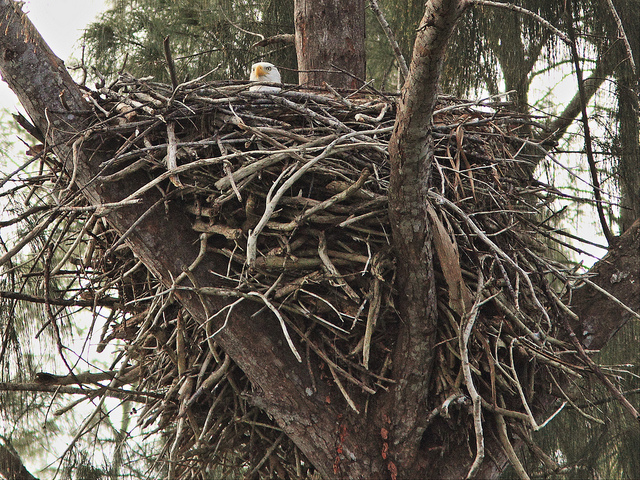 At 9:38 AM an immature Bald Eagle flew in directly from the west to east, in front of the nest and low over Pines Boulevard. It appears to be a 2nd year bird (a little over a year old) as it had a very dark head and its white was still rather limited to breast and underwing coverts. 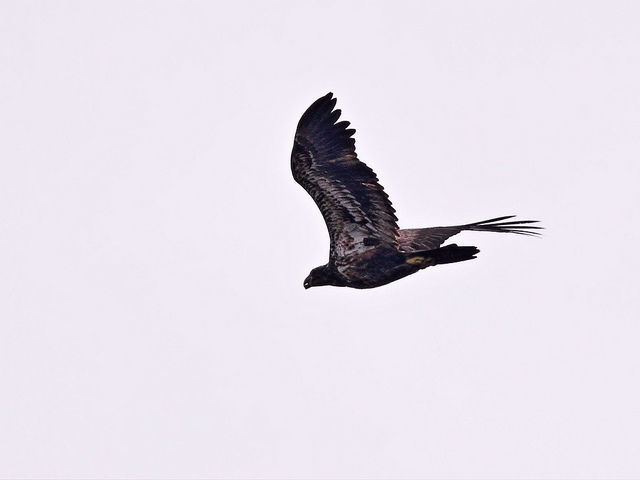 EDITED/CORRECTED JAN 5 2014: This nest produced one fledgling last year, so it is very likely to be that bird, as older ones would not be as likely to revisit the nest. It is a bit unusual to have one pass through this early in the winter, as most go north until spring, but the South Florida offspring may not migrate as far as those upstate. The adult changed position a few times and tended the nest or repositioned the eggs. 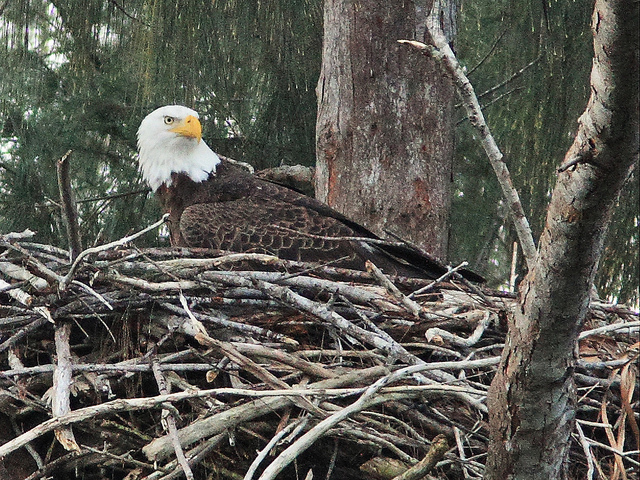 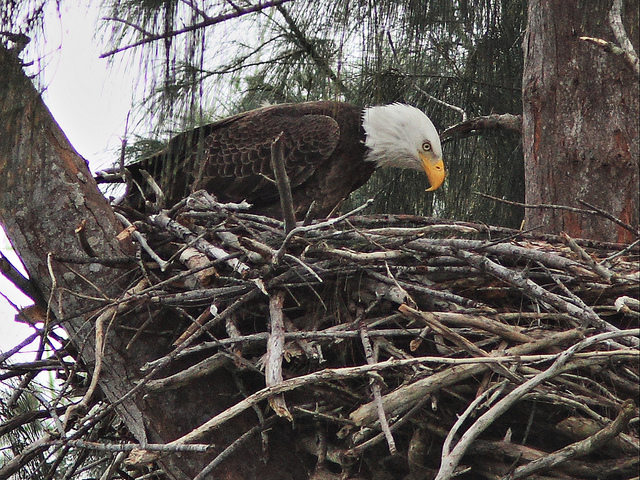 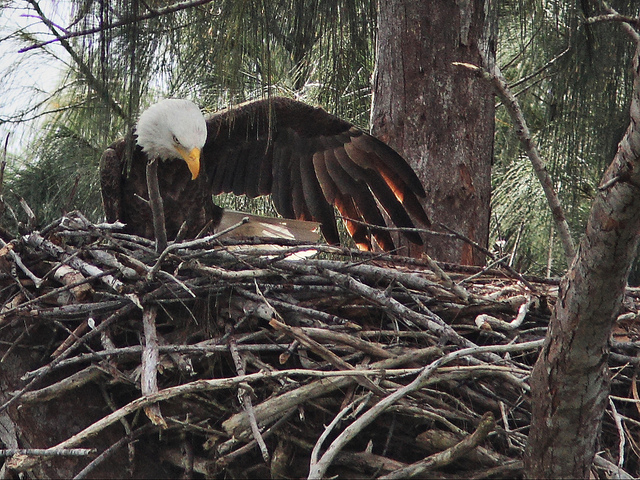 We watched until nearly 11:30, but the mate never appeared. Of course, I got a call from Kenny, who had joined us about an hour earlier, that Alix and I had missed the incubation exchange by only a few minutes.
Ken Schneider
Web site: http://rosyfinch.com Blog: http://rosy-finch.blogspot.com Photos: <http://flickr.com/photos/rosyfinch> |
|
Ken, this may be the fledgling that flew close to the nest tree last year (see May 31, 2013; 4:39 pm - Juvenile eagle over Harbour Lakes to the SE of nest tree), and perhaps the eaglet that was never observed fledging in 2012. As I remember, you received permission to search under the nest tree and did so, but never found the eaglet or evidence that it had perished. (See Mar 30, 2012 NewMexiKen Unsuccessful search for missing eaglet this morning MAR 30).
While we didn't want to be overly optimistic about the fate of the eaglet, and even though that eaglet and the parents did not follow some of the same behavior patterns (time remaining at the nest after fledging, adults remaining until after eaglet leaves), stranger things have happened. I believe that I read somewhere that year old fledgings sometimes visit the nest a few times after migrating. Maybe you know where I saw that. Nancy Boyle May 31, 2013; 4:39 pm - Juvenile eagle over Harbour Lakes to the SE of nest tree "This morning a first-year Bald Eagle soared over the wetlands west of Harbour Lakes subdivision and then circled over that subdivision and its large lake. ..." Mar 26, 2012; 2:43pm Re: Has Eaglet left the nest? Not seen March 23 You stated: "On March 23, the first day the nest appeared to be empty, the eaglet was 86 days old, assuming it was the first egg hatched, on January 15. Over the past three seasons, the oldest chick fledged when it was (respectively) 77. 81, and 68 days, an average of 75 (mean 74.5) days of age. The youngest chick fledged (respectively) 79, 91 and 70 days, an average of 80 (mean 80.5) days after the first egg hatched. If we hypothesize that this year's eaglet was not the first hatched, its age of 86 days, while above average, is not outside the range of dates observed for youngest nest-mates in past broods. (See the SUMMARY OF KEY OBSERVATIONS DURING EACH BALD EAGLE BREEDING SEASON (2007-Present) It is now important to determine the welfare of the eaglet. It should be capable of flight and may have relocated some distance away. This could account for the absence of adults at the nest site. In past years, adults were present most of the time during the period when eaglets left the nest. There is the possibility that it was injured or killed, not uncommon during the first days of free flight." Mar 30, 2012 NewMexiKen Unsuccessful search for missing eaglet this morning MAR 30 |
Re: Sunday JAN 5-- Immature Eagle fly-by and I miss the incubation exchange
|
Administrator
|
Sorry for my mistake, but I had such a busy winter last year that I got behind in my record-keeping. Our Daughter and her husband suffered broken legs quite independently in November 2012 and in January 2013, so we were in Illinois all winter and back and forth into spring, helping take care of their two little daughters.
The eaglet mortality occurred in the season before last, in 2012. The single eaglet presumably fledged prematurely and was lost. Therefore this bird is almost certainly the eaglet from last year (2013) as its plumage stage is consistent and also it is not as likely for an older eaglet to return to its natal nest. I have updated the tables and the spreadsheet to include the omitted data.
Ken Schneider
Web site: http://rosyfinch.com Blog: http://rosy-finch.blogspot.com Photos: <http://flickr.com/photos/rosyfinch> |
|
I was trying to upload our Picture of the Eagle not sure how to upload pictures on here .. I know it is the Eaglet from last year .. We watched this Eagle sit right above Joy and would not leave this Eagle was very comfortable being near Joy & the nest .. Even when Joy was calling for Pride the Eagle did not move .. this Eagle just looked at Joy like she knew her .. We are thinking it is a Female she is very big .. we watched her up on that branch near Joy for about 40 minutes then Joy did get her to leave then Pride showed up and it was very dark at that point . you can see the Pictures on our Facebook page ..I took my last picture of the Eaglet on May 19, 2013 so to see this Beautiful Eagle doing so well was a great treat for us all ...Nice Pictures Ken ..
https://www.facebook.com/pages/South-Florida-Pine-Eagle-Nest-Inc/537121543002300
UPDATE !!!! We are pleased to announce that we are now South Florida Pines Eagle Nest , Inc. a 501 C (3) as of November 18, 2015 Public Charity Status 170 (b) (1) (A) (vi) Employer Identification Number : 4-3116409 DLN: 26053716001635 . Donors can deduct contributions they make to us under IRC section 501 (c) (3) If you have Donated in the last 27 months your Donation is Tax Deductible .. Thank you!! If anyone has questions please feel free send an email to ag2761@comcast.net |
Re: Sunday JAN 5-- Immature Eagle fly-by and I miss the incubation exchange
|
Administrator
|
Nice photos, Lisa. I hoped you might place one of them here on the FORUM for the record. The procedure is rather simple-- I assume the photo is in a folder on your computer. Just start a reply to this message or start a new topic. Then select "Insert Image" at the tab just above the message box. This will display a pop-up menu. Click on the "Choose File" button and navigate to the photo. Click on the photo file, and then select the size-- the two largest sizes Medium or Big are ideal. It is best not to keep it the original size as it may be too large for the screen. Then before finishing you may check the message in the "Preview Message" button below.
An alternative and very simple way of uploading a photo that is already posted on an Internet site such as Facebook or Flickr is to simply click on the photo thumbnail to make it full sized, then right-click on the image. Select "Copy Image URL." This will result in an image that begins with "http" and has a ".JPG" file extension. Simply follow the first step above (Insert Image) but instead choose "Copy and image from the Internet." Paste the file you copied inside the box-- be sure it overwrites the "http://" that is already in the box. Select "Big Size" and simply click on the "Insert Image" button at the bottom of the box and PRESTO-- you are finished. Preview the message before posting to be sure is looks the way you want. For your convenience, I have copied your excellent photo of the juvenile that you took Sunday afternoon. I know it was your intention to place it here but please let me know if you have any objection. Photo by Lisa Garza ©2014 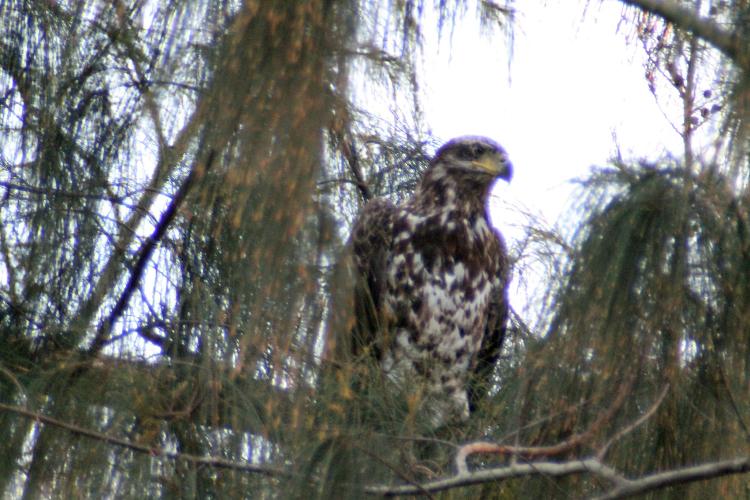
Ken Schneider
Web site: http://rosyfinch.com Blog: http://rosy-finch.blogspot.com Photos: <http://flickr.com/photos/rosyfinch> |
Re: Sunday JAN 5-- Immature Eagle fly-by and I miss the incubation exchange
|
Administrator
|
I assumed that the bird I photographed flying in front of the nest earlier in the day was the same one that Lisa later photographed at the nest. My impression was that it had a sharp demarcation between a uniformly dark head and neck and the white streaks on its belly. Lisa's photo suggests otherwise.
Yet in Lisa's photo this bird looks a bit older than I would expect one from last year's brood to appear. It has a less well-defined dark "bib" than expected on a second season bird. The bib has some bold white streaks and there is quite extensive white on its belly. Its bill is already turning yellow and the white streaks on its neck and face extend to the upper head area. A 1+ year old bird should have only a light line over its eye, a darker beak and a fairly uniform dark neck and head in addition to less white on lower belly. In this view I think the plumage pattern of this bird suggests that of a 2+ year old. It could be the same one I photographed earlier that day-- here is another poor photo of mine which, to me, suggested it was only 1+ years old: 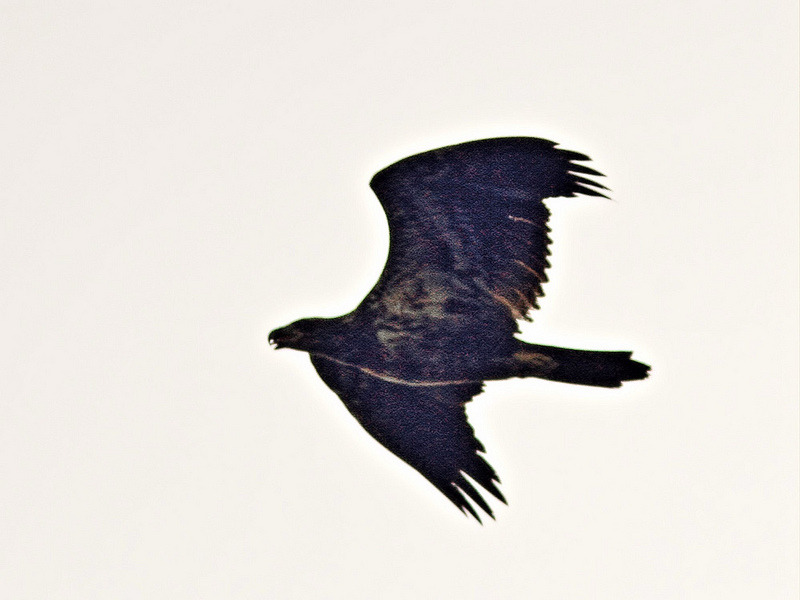 Its tail is quite long and shows sign of molting into shorter second year feathers, its flight feathers are uniform, not showing signs of ongoing molt, and the secondaries appear worn and rather long, suggesting they could be retained juvenile feathers as seen in a younger (2nd year) bird. That being said, the plumage stages are variable, and they may be based on those of eagles from the more northern reaches of its range. My opinion about the age of this bird is admittedly tentative. Lisa's photo seems to fit the "White-belly II" which is the third plumage stage seen in birds that are past 2 years of age (in their third year). Yet there may be variability and even some overlap between the classic stages. For example, some of the newly-fledged birds from this nest have shown more white on their belly and underwings than the field guides indicate. The fact that the bird came directly to the nest is a compelling reason to consider that it may indeed be a second year bird, the one that fledged last year. Maybe all Florida birds to not fit the same pattern as those from Alaska. Our youngsters hatch out in January while those in Alaska and Idaho hatch out in late March or early April. Perhaps the early start accelerates plumage changes. It would be interesting to hear how someone with more experience would analyze these photos. Perhaps Brian Mealey can offer an opinion as to the plumage stage of this bird.
Ken Schneider
Web site: http://rosyfinch.com Blog: http://rosy-finch.blogspot.com Photos: <http://flickr.com/photos/rosyfinch> |
«
Return to ARCHIVED 2013-2014 Pembroke Pines NESTING SEASON OBSERVATIONS AND PHOTOS
|
1 view|%1 views
| Free forum by Nabble | Edit this page |

